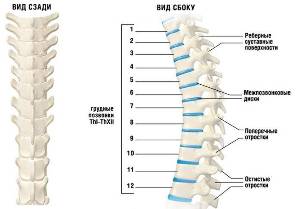At present, according to the data of health statistics, in the symptoms of degenerative disc disease, cervical complain that almost all people over the age of 25 to 30 years. The disease affects this department of the spinal column with more frequency than others. The pathology is a progressive degenerative process that affects the spinal discs and the vertebrae located in the neck. The disease is common among men and among women in the same way. It is dangerous and complex form of degenerative disc disease, as well as in the neck here there are large blood vessels that supply the brain, and a large number of nerve endings. The violation of innervation and the bleeding will lead to a deterioration of the guarantee the brain of oxygen and nutrients.

Signs of the disease
The symptoms of degenerative disc disease, cervical manifest more pronounced than in other parts of the vertebral column, including small lesions. This is because in the neck the vertebrae lie here close to one another, to the intervertebral discs m? s have a small height. This anatomical characteristic, which favors the osteochondrosis more compressed the nerve endings of the spinal cord, the blood vessels.
Common symptoms:
- pain syndrome;
- the weakness and the reduction of the sensitivity in the upper extremities;
- limitation of neck mobility;
- lack of coordination of movements;
- frequent dizziness;
- the general weakness;
- the deterioration of the functioning of the senses (hearing, sight, touch, taste).
The pain is often located in the neck, in the nape of the neck, the shoulders, the arms. The upper extremities hurt, if damaged vertebra, trapped nerve root, which is responsible for its innervation. The pain in the nape of the neck based on the spastic contractions of the muscles of the neck, attached to occipital bone, and the violation of the circulation of the blood in this area.
Weakness of the arms was observed in the patients, if in the process of the encasement of nerves in the loin, which provides innervation muscle structures of the upper extremities. Limitation of the mobility and the characteristic crack when it rotates or tilts the neck occur, if cervical vertebrae appear bony growths, the height of the intervertebral discs is reduced, the involvement of the joints, located between vertebrae.
The vertebrae in the neck have cross rods, forming a channel that passes the artery that feeds the brain. The osteochondrosis of cervical vertebrae move in them grows the connective tissue. This leads to a pinch cervical artery, the degradation of the vascularization of the cerebellum and rear areas in the brain. In consequence, the man frequent dizziness, broken coordination of movements, general weakness. In those cases, if the artery is involved in a pathological process or very pinched, the blood supply, the cerebellum, the occipital part and in the brain stem deteriorates considerably. In this case, it reduces the functionality of the organs of hearing, of sight, is observed numbness of the tongue, the fingers.
Signs of the disease depends, and depending on which of the eight vertebrae surprised degenerative, or inflammatory process. The disorders of sensibility and motion damage to spinal roots, in the that influence the different vertebrae. In function of this, observe the following manifestations of the degenerative disc disease cervical:

- the first vrtebra – numb neck and the occipital part of the head, reduces sensitivity;
- the second – feels pain in the area of the crown and the nape of the neck;
- the third – feel the pain and decreases the sensitivity in the part of the neck, where it lies wedged in cerebrospinal fluid, spine, reduces the intensity of the flavors, there are problems with speech;
- fourth – the pain radiates to the shoulder, the paddle, the patient bother heart pain, disorders of the breathing, lowers the tone of the musculature of the neck;
- the fifth is the feeling of pain is observed in neck, give on the outer surface of the shoulder;
- sixth pain in the neck radiating to the spatula, is felt in the forearm and the fingers of the large;
- seventh sorrow give in the paddle, the back of the shoulder, the forearm and the fingers of the hands (second to fourth);
- eighth – pain extending from the neck to the shoulders, forearms and Pinkies.
In function of the prevalence of the defeat differentiate four degrees of degenerative disc disease cervical. It is not the stage of the disease and the severity of symptoms, conditioned by the fact, so common is a pathological process, what are are the vertebrae affected.
- In the first degree of the clinical symptoms are missing or are manifested at a minimum. Patients complain of slightly pain, the increase in the movements of the head. Effective in the treatment initiated in this stage of the disease. However, people often ignore warning signs or don't feel, why not go to the doctor.
- The aggravation of the injury process increases the symptoms. In the second stage of pain become more pronounced, occur in the upper extremity, the scapula. At this stage of development degenerative process of the height of the intervertebral of the unit is reduced, due to which occurs the crushing of the nerve fiber. This becomes the cause of intensification of the pain. For the second grade of degenerative disc disease, cervical characterized by the appearance of headaches, deterioration of well-being, decreased work capacity.
- The third degree of the degenerative disease of the cervical disc is different from the education of the hernia affected intervertebral disc. The mobility of the neck is limited, by palpation the patient feels expressed by the pain. With this distribution of the pathological process pain become permanent, radiant in the upper extremities. You feel the tension in the muscle, attached to occipital bone. Patients complain of frequent dizziness, general weakness, numbness of the hands.
- The fourth degree of the degenerative disc disease cervical is diagnosed when the intervertebral disc is completely destroyed degenerative process. Is replaced by tissue of the fabric, which results in a great limitation of the mobility. Surprise of the spinal cord and extend into the neck of the blood vessels. These changes are characterized by a considerable impairment of the vascularization of the cerebellum and the occipital part of the brain. Hypoxia leads to disruption of the coordination of movements, impairment of hearing, sight, numbness of language, voice disorders.
Methods of treatment
Call a doctor in case of occurrence of the anxiety of the first symptoms, the discomfort in the neck, the reactions on the part of the nervous system, to prevent the progression of degenerative changes. The treatment of degenerative disc disease, cervical consists of a complex of therapeutic activities. Among them:
- take the medications;
- massage;
- therapeutic exercise;
- physical therapy procedures.
Medical therapy
Doctors prescribe anti-inflammatory drugs to reduce the intensity of painful sensations, reducing the inflammatory process and inflammation of the nerve root. Chondroprotectors recover the tissue damaged cartilage in intervertebral disc. Muscle relaxants can relax the neck muscles, relieve spasm. Medications to improve blood flow helping to restore restricted blood supply to the brain. Vitamins activate the metabolism in the nervous tissue. When the intense sensations of pain, the doctor can assign analgesic medications. If the patient expressed pain syndrome, what pain relievers are introduced by the parenteral route, after the pain calm down, go on the pill.
The physiotherapeutic methods
Physical therapy – an effective way to fight against osteochondrosis cervical. Treatment of the disease necessarily with the use of these techniques, as a result of which we obtain the following results:
- decreases the intensity of pain
- it enables the recovery of those affected, the bones, the cartilage and muscle tissue;
- removes the spasm and tension in the muscles;
- coupled the inflammatory process;
- improves the transportation of oxygen and nutrients to the affected area and the brain.
One of the most effective in the treatment of osteochondrosis are considered the following types of procedures:
- a electrophoresis (in the affected area affect power in addition to intensify blood flow and the recovery of the tissue, enhancing delivery of the active substance of the medicine to be surprised by a degenerative process to the tissues);
- the ultrasound therapy (they activate processes of exchange in the diseased area, decreases pain, coupled with inflammation);
- magnet (eliminates the swelling of the affected area, which helps to reduce the intensity of the pain);
- lazeroterapiya (improves the circulation of blood in the area of pathological process, has anti-inflammatory effect).
Therapeutic exercise
The exercises are assigned in the period, when cut acute symptoms of the disease. At the time of the gym should not feel the discomfort and the pain. Perform complex must reach the support of the referral for relapse prevention.

- Accept the position, being in the belly, lift the head and the body, relying on the hands. The back straight, breathing deep and even. Staying in one position for a minute or two, then slowly take the starting position. The number of repetitions – 3.
- Position: lying on the belly, arms along the body. Turn head slowly, trying to touch the ear to the ground. Repeat 6 times on each side.
- Sitting or standing, on the inhalation, tilt your head, trying to reach your chin to the chest. As you exhale gently move the head to is a player, he lifted up his eyes to the ceiling. The number of repetitions and 10-15.
- A good exercise for strengthening the cervical muscles – press the front tap him on the hand. To achieve the effect it is necessary to press and the palms of the hands in the front and the front in the palm of the hand for 30 seconds. Repeat three times.
- Rotate the head in a circle. Exercise slowly, gently. On each side – 10 laps. It is inadmissible that the emergence of dizziness when performing the movements. If this occurs, you should stop immediately.
Massage
The course will be assigned a doctor in the period of absence of acute pain, spending can only be a specialist health and education. When this disease is not recommended to go to users for non-experts to understand.
Therapeutic effects of massage of nuchal translucency:
- improves the flow of blood and lymph in the affected area;
- it relaxes the muscles, removes the spasm;
- decreases the intensity of the sensations are painful.
The surgical intervention
The operation is shown, if the conservative treatment does not bring results within six months, the patient is concerned about pain, there are signs of damage in nerve fibers and myelopathy. If the osteochondrosis cervical with complications, there is the threat of a stroke, there is a strong squeezing of the spinal cord, it is necessary to the operation.
Indications resort to the following types of surgical interventions:
- endoscopic discectomy – the removal of a part or all of an intervertebral disc;
- the laminotomy – excision of bone, ligaments and accumulated bone particles (which are often combined with laminoplasty – establishing artificial plates for the expansion of spinnomozgovogo channel);
- laser vaporization disc nucleus – the division of the nucleus intervertebral disc of a laser beam at the same time with the destruction of its ruins, fragments;
- cold plasma nucleoplasty – in place of endoscope used long, thin, hollow needle that is inserted into the intervertebral the unit, through it to the place of the defeat are the electrode, that the impact of cold plasma impact.
The neck is a body in which they spend the major blood vessels, the spinal cord. Easy to damage, so that the operational interventions and resort to no more than 5% of the cases. The surgical treatment often accompanied by the development of complications. Among them:
- the inflammatory process in the tissues or the lining of the spinal cord;
- osteomyelitis;
- the formation of the scar, which leads to a narrowing of blood and spinnomozgovogo channels.
The operation in the cervical region of the spine are complex and require a long rehabilitation period. The recovery of the patient after the surgery occupies a period of between six months and more.
The prevention of the
To prevent the development of degenerative disc disease cervical you must:
- observing the situation of the spine and the neck;
- lead an active lifestyle, move more;
- making exercise a physical, you must be careful to respect the correct execution, since even small injuries can affect the state of the locomotor system;
- take care of the correct position of the body during sleep, buy orthopedic or mattress;
- to properly install the work place, where the person spends a lot of time;
- regularly physical culture;
- follow the diet, to ensure the income of all the benefits of the minerals necessary for the strength of the bones, especially of magnesium and calcium;
- constantly pass dispensary survey for the early detection of a degenerative disc disease.
Prevention will help to prevent degenerative changes in the cervical spine, the day avoiding pain, dizziness, numbness of the extremities, and other unpleasant symptoms.




























